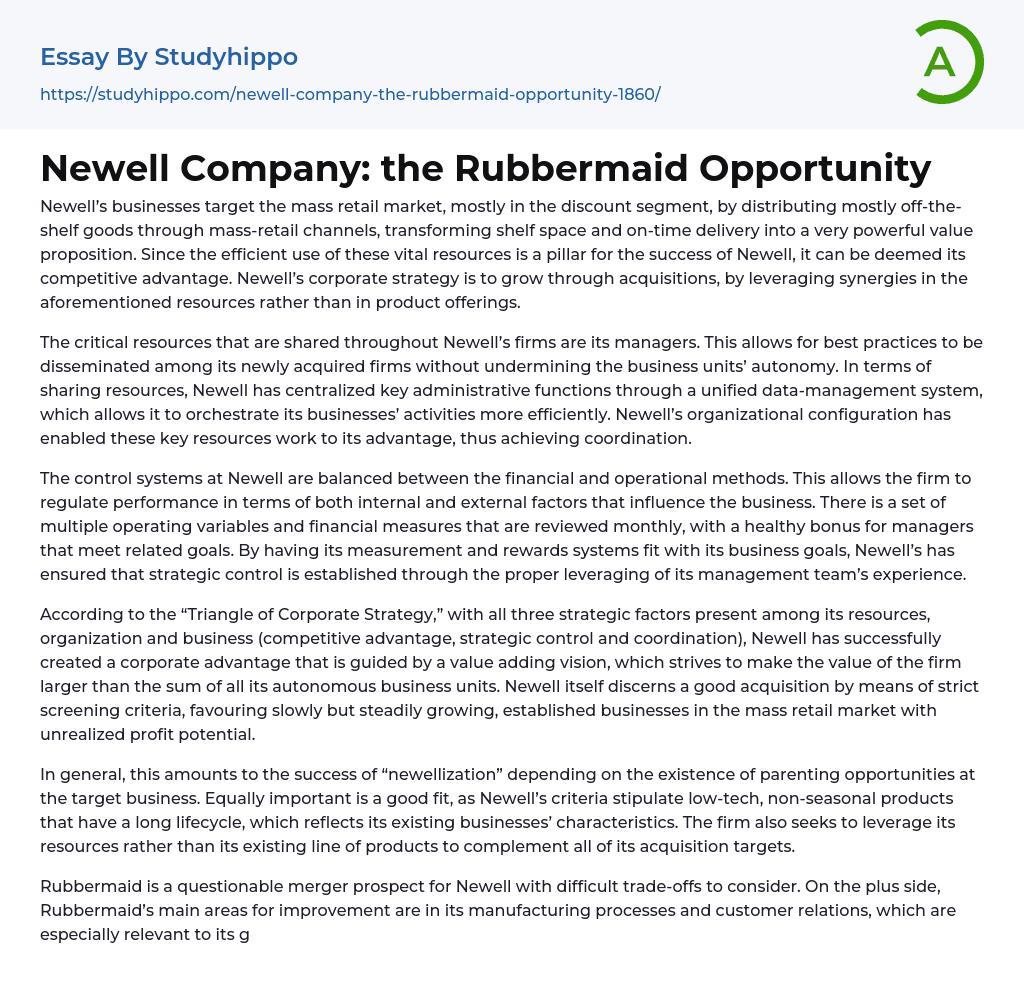Newell’s businesses target the mass retail market, mostly in the discount segment, by distributing mostly off-the-shelf goods through mass-retail channels, transforming shelf space and on-time delivery into a very powerful value proposition. Since the efficient use of these vital resources is a pillar for the success of Newell, it can be deemed its competitive advantage. Newell’s corporate strategy is to grow through acquisitions, by leveraging synergies in the aforementioned resources rather than in product offerings.
The critical resources that are shared throughout Newell’s firms are its managers. This allows for best practices to be disseminated among its newly acquired firms without undermining the business units’ autonomy. In terms of sharing resources, Newell has centralized key administrative functions through a unified data-management system, which allows it to orchestrate its businesses’ activities more efficiently. Newell’s organizational configurati
...on has enabled these key resources work to its advantage, thus achieving coordination.
The control systems at Newell are balanced between the financial and operational methods. This allows the firm to regulate performance in terms of both internal and external factors that influence the business. There is a set of multiple operating variables and financial measures that are reviewed monthly, with a healthy bonus for managers that meet related goals. By having its measurement and rewards systems fit with its business goals, Newell’s has ensured that strategic control is established through the proper leveraging of its management team’s experience.
According to the “Triangle of Corporate Strategy,” with all three strategic factors present among its resources, organization and business (competitive advantage, strategic control and coordination), Newell has successfully created a corporate advantage that is guided by a value adding vision, which strives to make th
value of the firm larger than the sum of all its autonomous business units. Newell itself discerns a good acquisition by means of strict screening criteria, favouring slowly but steadily growing, established businesses in the mass retail market with unrealized profit potential.
In general, this amounts to the success of “newellization” depending on the existence of parenting opportunities at the target business. Equally important is a good fit, as Newell’s criteria stipulate low-tech, non-seasonal products that have a long lifecycle, which reflects its existing businesses’ characteristics. The firm also seeks to leverage its resources rather than its existing line of products to complement all of its acquisition targets.
Rubbermaid is a questionable merger prospect for Newell with difficult trade-offs to consider. On the plus side, Rubbermaid’s main areas for improvement are in its manufacturing processes and customer relations, which are especially relevant to its global ambitions. Newell can add value through its efficient shipping, manufacturing and excellent customer relations. Rubbermaid also has a strong brand as well as ambitious management attitudes that are compatible with Newell’s.
On the other hand, while both companies were targeting the same consumers, the competition in the Rubbermaid market requires them to be more innovative to stay afloat, and innovation is not a resource at Newell; while certain resource synergies do exist between Newell and Rubbermaid, their cost structures, production processes and value propositions are very different. Moreover, Newell is a low-cost producer of mainly unbranded products, and it might not understand how to market a brand name in Rubbermaid.
Furthermore, the sheer size of Rubbermaid (45% of Newell, as per assets) will make it very difficult to transfer/share resources in order to successfully
“newellize” Rubbermaid within the target time frame of 2-3 years. This merger prospect could be considered “borderline heartland,” rendering the strategic fit between the two firms highly uncertain. Newell’s goals are to get both operating profit (OP) margin and SGA expenses to a level of 15%; examining Rubbermaid’s financial information, its historical figures are at an of average 10% and 18%, respectively.
Newell’s goal therefore constitutes an improvement of nearly 50% in OP in an environment with increasing raw material costs and conflicting resource synergies. Additionally, the dilution of equity will work against Newell’s goal of 15% growth in EPS. Finally, predicting an increase of 325M in OP for the combined companies represents a CAGR of 18%, a somewhat ambitious goal in an uncertain environment. Thus, the projected benefits seem very optimistic, especially given the fact that Newell has no precedent in an acquisition of this size. Given the premium price tag attached, I would vote against this acquisition.
- Bankruptcy essays
- Earnings essays
- Tata Group essays
- S corporation essays
- Secretary essays
- Premise essays
- Adidas essays
- Amazon essays
- Apple essays
- Bmw essays
- British Airways essays
- Burger King essays
- Coca-Cola essays
- Company essays
- Costco essays
- Dell essays
- Ebay essays
- Enron essays
- Facebook essays
- Ford Motor Company essays
- Gap essays
- General Motors essays
- Google essays
- Honda essays
- Ibm essays
- Ikea essays
- Intel essays
- Iphone essays
- Johnson and Johnson essays
- Kellogg essays
- Key essays
- Kfc essays
- Mcdonald's essays
- Microsoft essays
- Myspace essays
- Nestle essays
- Netflix essays
- Nike essays
- Nokia essays
- Pepsi essays
- Pepsico essays
- Red Bull essays
- Ryanair essays
- Samsung essays
- Sony essays
- Southwest Airlines essays
- Starbucks essays
- Supermarket essays
- Tesco essays
- Toyota essays




